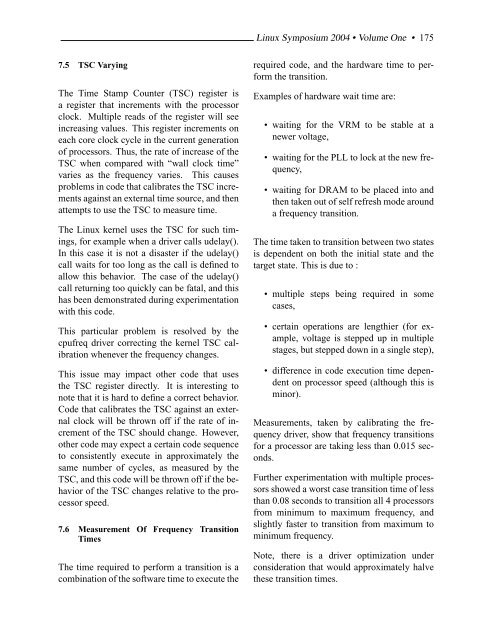Create successful ePaper yourself
Turn your PDF publications into a flip-book with our unique Google optimized e-Paper software.
<strong>Linux</strong> Symposium 2004 • Volume <strong>One</strong> • 175<br />
7.5 TSC Varying<br />
<strong>The</strong> Time Stamp Counter (TSC) register is<br />
a register that increments with the processor<br />
clock. Multiple reads of the register will see<br />
increasing values. This register increments on<br />
each core clock cycle in the current generation<br />
of processors. Thus, the rate of increase of the<br />
TSC when compared with “wall clock time”<br />
varies as the frequency varies. This causes<br />
problems in code that calibrates the TSC increments<br />
against an external time source, and then<br />
attempts to use the TSC to measure time.<br />
<strong>The</strong> <strong>Linux</strong> kernel uses the TSC for such timings,<br />
for example when a driver calls udelay().<br />
In this case it is not a disaster if the udelay()<br />
call waits for too long as the call is defined to<br />
allow this behavior. <strong>The</strong> case of the udelay()<br />
call returning too quickly can be fatal, and this<br />
has been demonstrated during experimentation<br />
with this code.<br />
This particular problem is resolved by the<br />
cpufreq driver correcting the kernel TSC calibration<br />
whenever the frequency changes.<br />
This issue may impact other code that uses<br />
the TSC register directly. It is interesting to<br />
note that it is hard to define a correct behavior.<br />
Code that calibrates the TSC against an external<br />
clock will be thrown off if the rate of increment<br />
of the TSC should change. However,<br />
other code may expect a certain code sequence<br />
to consistently execute in approximately the<br />
same number of cycles, as measured by the<br />
TSC, and this code will be thrown off if the behavior<br />
of the TSC changes relative to the processor<br />
speed.<br />
7.6 Measurement Of Frequency Transition<br />
Times<br />
<strong>The</strong> time required to perform a transition is a<br />
combination of the software time to execute the<br />
required code, and the hardware time to perform<br />
the transition.<br />
Examples of hardware wait time are:<br />
• waiting for the VRM to be stable at a<br />
newer voltage,<br />
• waiting for the PLL to lock at the new frequency,<br />
• waiting for DRAM to be placed into and<br />
then taken out of self refresh mode around<br />
a frequency transition.<br />
<strong>The</strong> time taken to transition between two states<br />
is dependent on both the initial state and the<br />
target state. This is due to :<br />
• multiple steps being required in some<br />
cases,<br />
• certain operations are lengthier (for example,<br />
voltage is stepped up in multiple<br />
stages, but stepped down in a single step),<br />
• difference in code execution time dependent<br />
on processor speed (although this is<br />
minor).<br />
Measurements, taken by calibrating the frequency<br />
driver, show that frequency transitions<br />
for a processor are taking less than 0.015 seconds.<br />
Further experimentation with multiple processors<br />
showed a worst case transition time of less<br />
than 0.08 seconds to transition all 4 processors<br />
from minimum to maximum frequency, and<br />
slightly faster to transition from maximum to<br />
minimum frequency.<br />
Note, there is a driver optimization under<br />
consideration that would approximately halve<br />
these transition times.

















